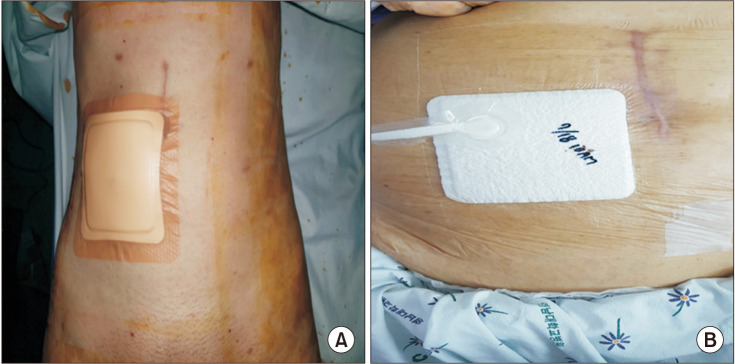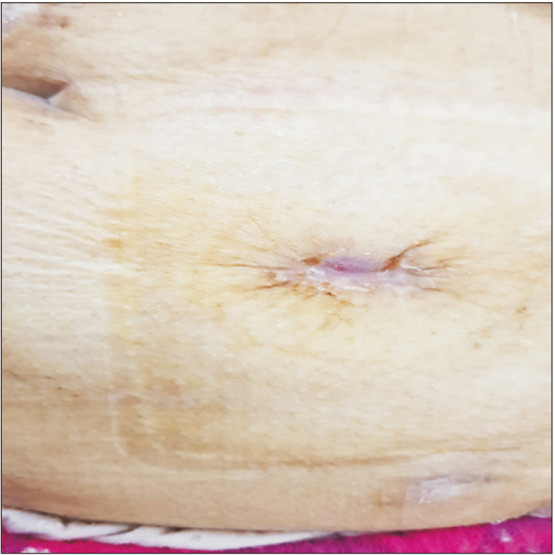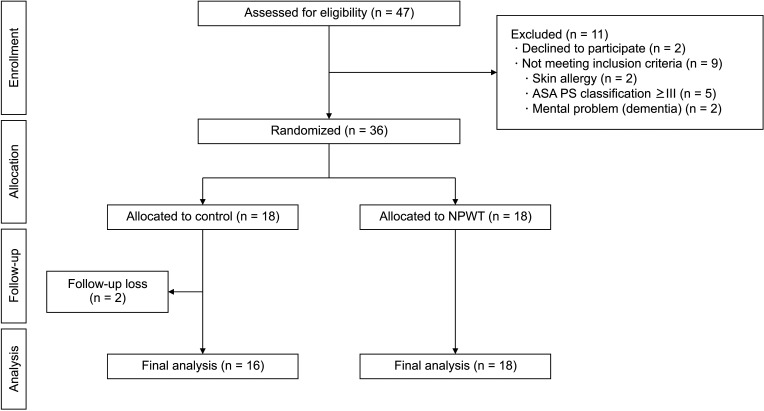Ann Surg Treat Res.
2023 Sep;105(3):126-132. 10.4174/astr.2023.105.3.126.
The effectiveness of negative-pressure wound therapy for wound healing after stoma reversal: a randomized control study
- Affiliations
-
- 1Department of Surgery, Yeungnam University Medical Center, Yeungnam Uiversity College of Medicine, Daegu, Korea
- KMID: 2545903
- DOI: http://doi.org/10.4174/astr.2023.105.3.126
Abstract
- Purpose
The purse-string closure (PSC) method is used for skin closure after stoma reversal to reduce surgical site infections (SSIs). However, PSC requires a longer healing period than primary closure. The application of negativepressure wound therapy (NPWT) may reduce the healing period of many wound types. This study aimed to investigate whether the application of NPWT promotes wound healing after the PSC method for stoma reversal.
Methods
This study was a randomized controlled study. Patients who had undergone stoma reversal surgery were randomized to receive NPWT or simple dressing after surgery. The primary outcome was a complete wound-healing period. We also investigated SSI, hospital stay, total cost, and the patient and observer scar assessment scale (POSAS) as secondary outcomes.
Results
A total of 36 patients were randomized into 2 groups. The median wound healing period was shorter in the NPWT group than in the control group (17.5 days [range, 11–24 days] vs. 21.5 days [range, 14–41 days], P = 0.006). SSI rate and hospital stay did not differ between the groups. However, the number of dressings was lower in the NPWT group than in the control group (5 [range, 3–7] vs. 17 [range, 10–30], P < 0.001). The total cost for dressing was comparable between the groups. The POSAS was not different between the groups.
Conclusion
This study revealed that NPWT application after PSC for stoma reversal site is effective in reducing the wound healing period compared to simple dressing, without increasing SSI and total cost.
Figure
Reference
-
1. Klink CD, Wünschmann M, Binnebösel M, Alizai HP, Lambertz A, Boehm G, et al. Influence of skin closure technique on surgical site infection after loopileostomy reversal: retrospective cohort study. Int J Surg. 2013; 11:1123–1125. PMID: 24035923.
Article2. McCartan DP, Burke JP, Walsh SR, Coffey JC. Purse-string approximation is superior to primary skin closure following stoma reversal: a systematic review and meta-analysis. Tech Coloproctol. 2013; 17:345–351. PMID: 23354904.
Article3. Hajibandeh S, Hajibandeh S, Kennedy-Dalby A, Rehman S, Zadeh RA. Purse-string skin closure versus linear skin closure techniques in stoma closure: a comprehensive meta-analysis with trial sequential analysis of randomised trials. Int J Colorectal Dis. 2018; 33:1319–1332. PMID: 30074070.
Article4. Camacho-Mauries D, Rodriguez-Díaz JL, Salgado-Nesme N, González QH, Vergara-Fernández O. Randomized clinical trial of intestinal ostomy takedown comparing pursestring wound closure vs conventional closure to eliminate the risk of wound infection. Dis Colon Rectum. 2013; 56:205–211. PMID: 23303149.
Article5. O'Leary DP, Peirce C, Anglim B, Burton M, Concannon E, Carter M, et al. Prophylactic negative pressure dressing use in closed laparotomy wounds following abdominal operations: a randomized, controlled, open-label trial. The P.I.C.O. trial. Ann Surg. 2017; 265:1082–1086. PMID: 27926575.6. Zaidi A, El-Masry S. Closed-incision negative-pressure therapy in high-risk general surgery patients following laparotomy: a retrospective study. Colorectal Dis. 2017; 19:283–287. PMID: 27416813.
Article7. Liu Z, Dumville JC, Hinchliffe RJ, Cullum N, Game F, Stubbs N, et al. Negative pressure wound therapy for treating foot wounds in people with diabetes mellitus. Cochrane Database Syst Rev. 2018; 10:CD010318. PMID: 30328611.
Article8. Schulz KF, Altman DG, Moher D. CONSORT Group. CONSORT 2010 statement: updated guidelines for reporting parallel group randomised trials. Trials. 2010; 11:32. PMID: 20334632.
Article9. Kim S, Kang SI. The effectiveness of negative-pressure wound therapy for wound healing after stoma reversal: a randomised control study (SR-PICO study). Trials. 2020; 21:24. PMID: 31907033.
Article10. Horan TC, Gaynes RP, Martone WJ, Jarvis WR, Emori TG. CDC definitions of nosocomial surgical site infections, 1992: a modification of CDC definitions of surgical wound infections. Infect Control Hosp Epidemiol. 1992; 13:606–608. PMID: 1334988.
Article11. Draaijers LJ, Tempelman FR, Botman YA, Tuinebreijer WE, Middelkoop E, Kreis RW, et al. The patient and observer scar assessment scale: a reliable and feasible tool for scar evaluation. Plast Reconstr Surg. 2004; 113:1960–1967. PMID: 15253184.
Article12. Song YP, Wang L, Yuan BF, Shen HW, Du L, Cai JY, et al. Negative-pressure wound therapy for III/IV pressure injuries: a meta-analysis. Wound Repair Regen. 2021; 29:20–33. PMID: 32989919.
Article13. Glass GE, Murphy GF, Esmaeili A, Lai LM, Nanchahal J. Systematic review of molecular mechanism of action of negative-pressure wound therapy. Br J Surg. 2014; 101:1627–1636. PMID: 25294112.
Article14. Huang C, Leavitt T, Bayer LR, Orgill DP. Effect of negative pressure wound therapy on wound healing. Curr Probl Surg. 2014; 51:301–331. PMID: 24935079.
Article15. Ma Z, Shou K, Li Z, Jian C, Qi B, Yu A. Negative pressure wound therapy promotes vessel destabilization and maturation at various stages of wound healing and thus influences wound prognosis. Exp Ther Med. 2016; 11:1307–1317. PMID: 27073441.
Article16. Hsieh MC, Kuo LT, Chi CC, Huang WS, Chin CC. Pursestring closure versus conventional primary closure following stoma reversal to reduce surgical site infection rate: a meta-analysis of randomized controlled trials. Dis Colon Rectum. 2015; 58:808–815. PMID: 26163961.
Article17. Carrano FM, Maroli A, Carvello M, Foppa C, Sacchi M, Crippa J, et al. Negative-pressure wound therapy after stoma reversal in colorectal surgery: a randomized controlled trial. BJS Open. 2021; 5:zrab116. PMID: 34904647.
Article18. Heard C, Chaboyer W, Anderson V, Gillespie BM, Whitty JA. Cost-effectiveness analysis alongside a pilot study of prophylactic negative pressure wound therapy. J Tissue Viability. 2017; 26:79–84. PMID: 27320010.
Article19. Obeid N, Sharma E, Dunstan M, Nisar P, Trivedi P, Madani R, et al. Negative pressure therapy for stoma closure sites-a nonrandomised case control study. Int J Colorectal Dis. 2021; 36:161–167. PMID: 32929529.
Article20. Lee JT, Marquez TT, Clerc D, Gie O, Demartines N, Madoff RD, et al. Pursestring closure of the stoma site leads to fewer wound infections: results from a multicenter randomized controlled trial. Dis Colon Rectum. 2014; 57:1282–1289. PMID: 25285695.21. Sureshkumar S, Jubel K, Ali MS, Vijayakumar C, Amaranathan A, Sundaramoorthy S, et al. Comparing surgical site infection and scar cosmesis between conventional linear skin closure versus purse-string skin closure in stoma reversal: a randomized controlled trial. Cureus. 2018; 10:e2181. PMID: 29657907.
- Full Text Links
- Actions
-
Cited
- CITED
-
- Close
- Share
- Similar articles
-
- Negative-Pressure Wound Therapy in a Patient with Osteomyelitis Caused by Multidrug-Resistant Bacterial Infection: A Case Report
- Clinical Experience of Negative Pressure Wound Therapy with Instillation
- Negative Pressure Wound Therapy for Traumatic Soft Tissue Defects
- Wound coverage using advanced technology in Korea
- The Utility of Disposable Negative Pressure Wound Therapy (PICO) in Wound Healing of Latissimus Dorsi Musculocutaneous Flap Donor Sites





